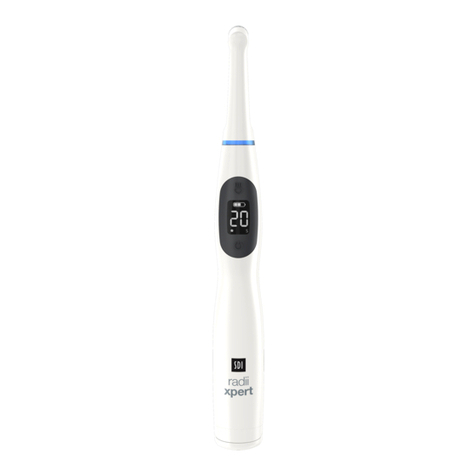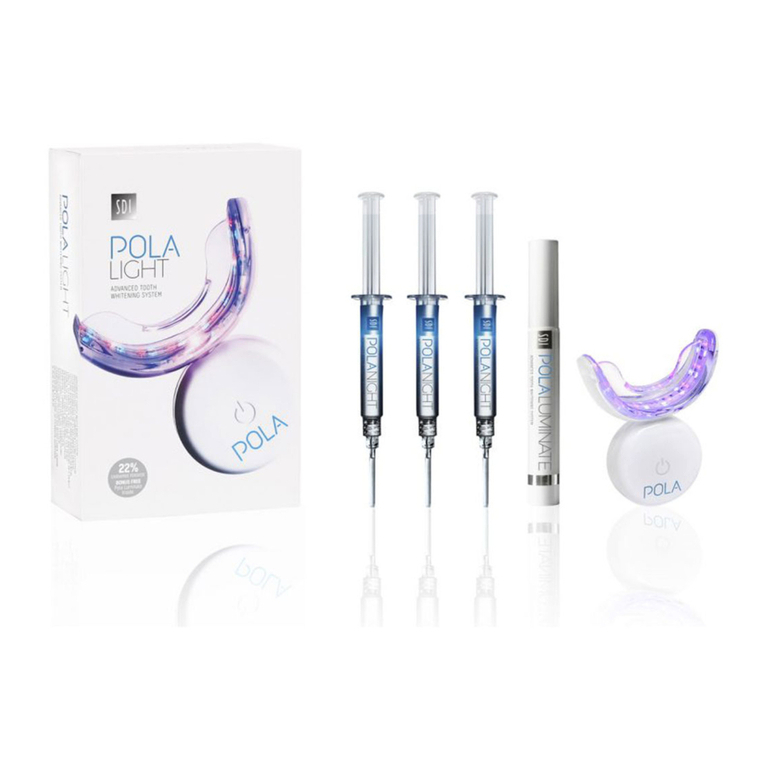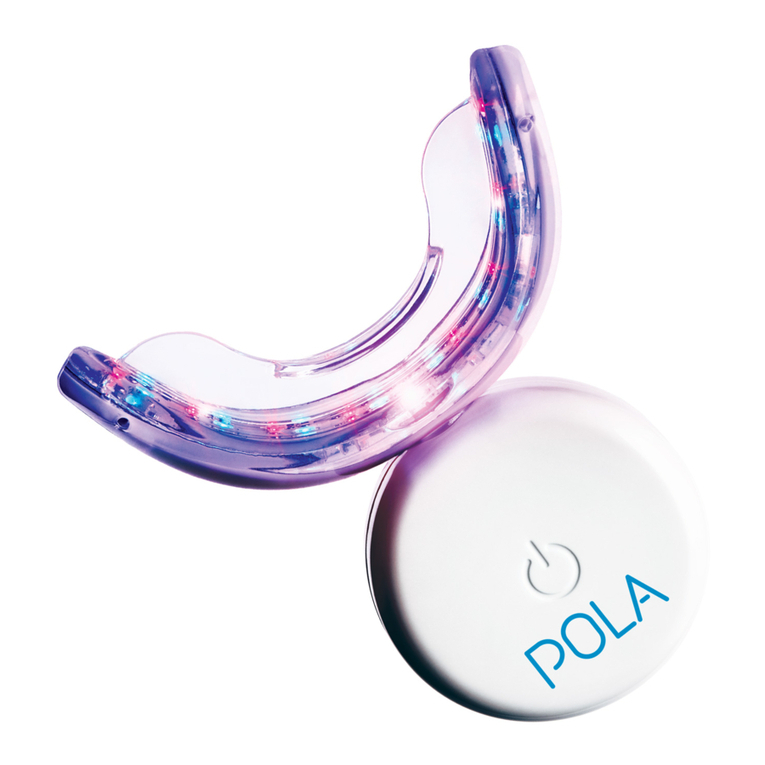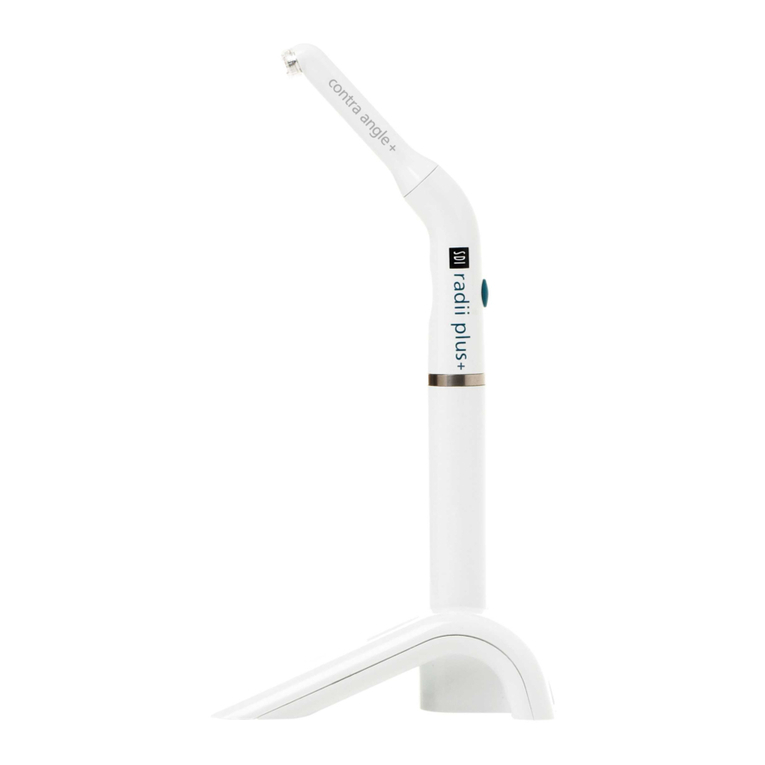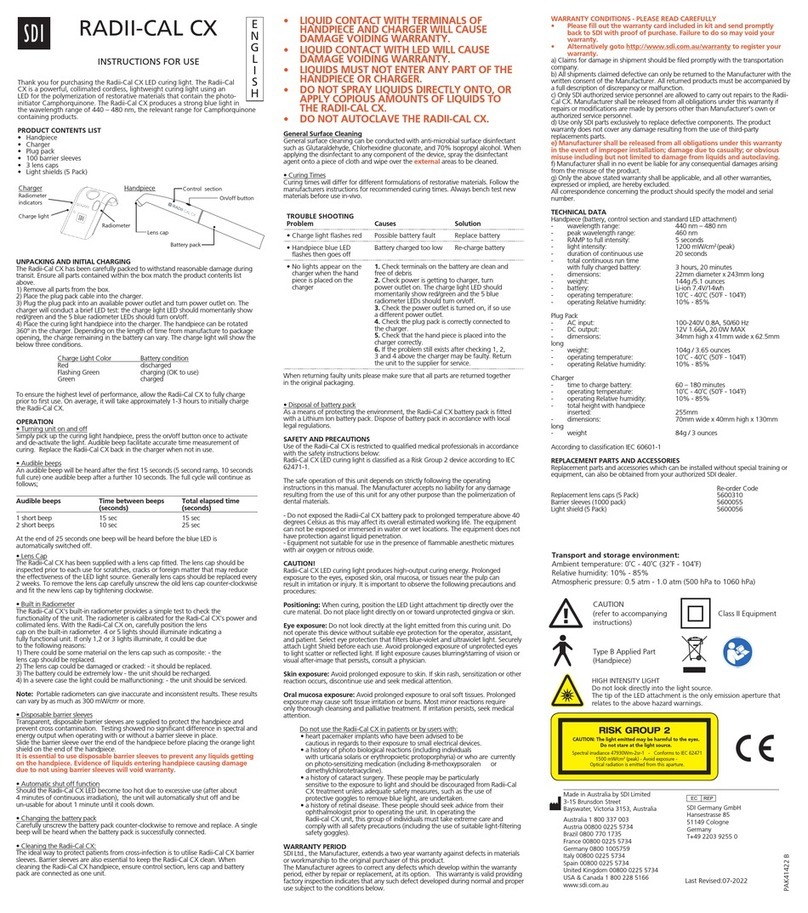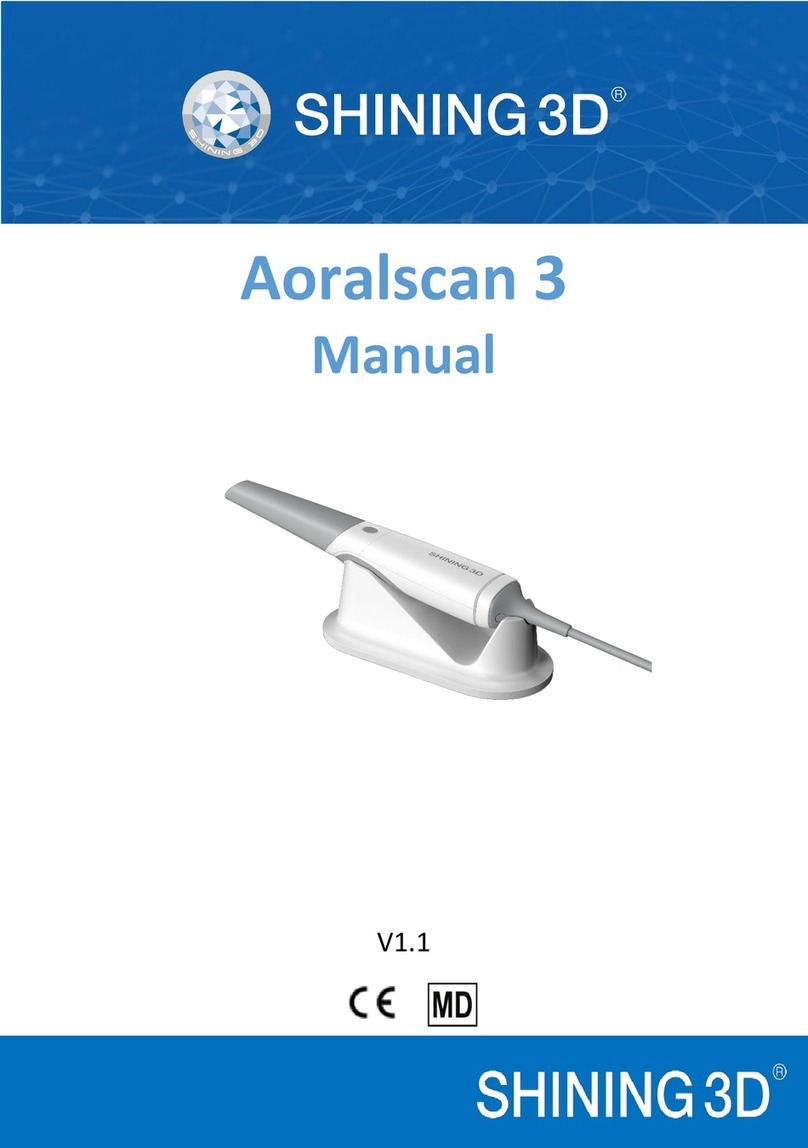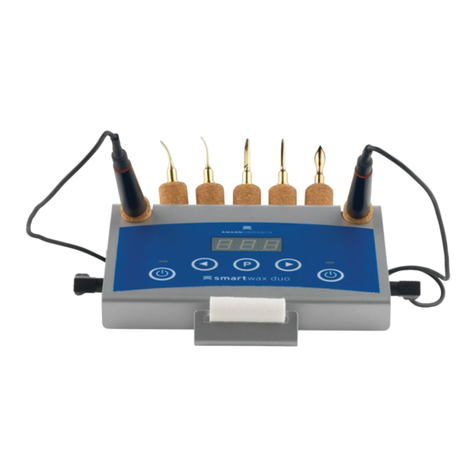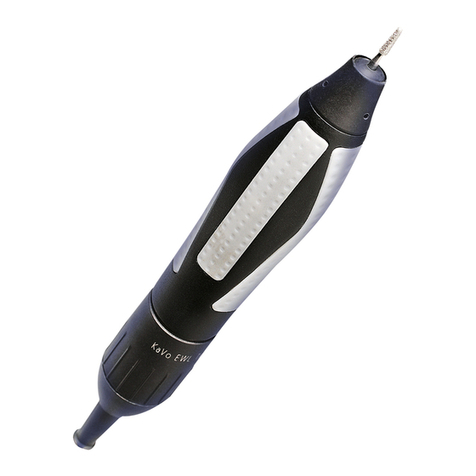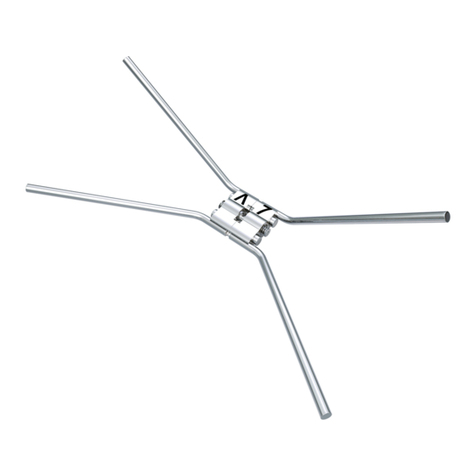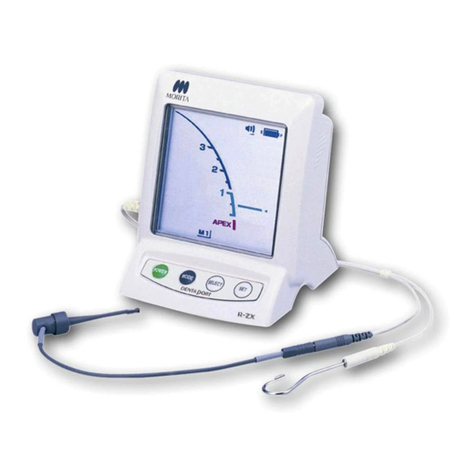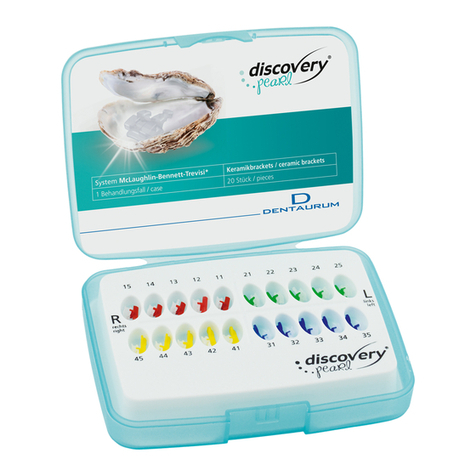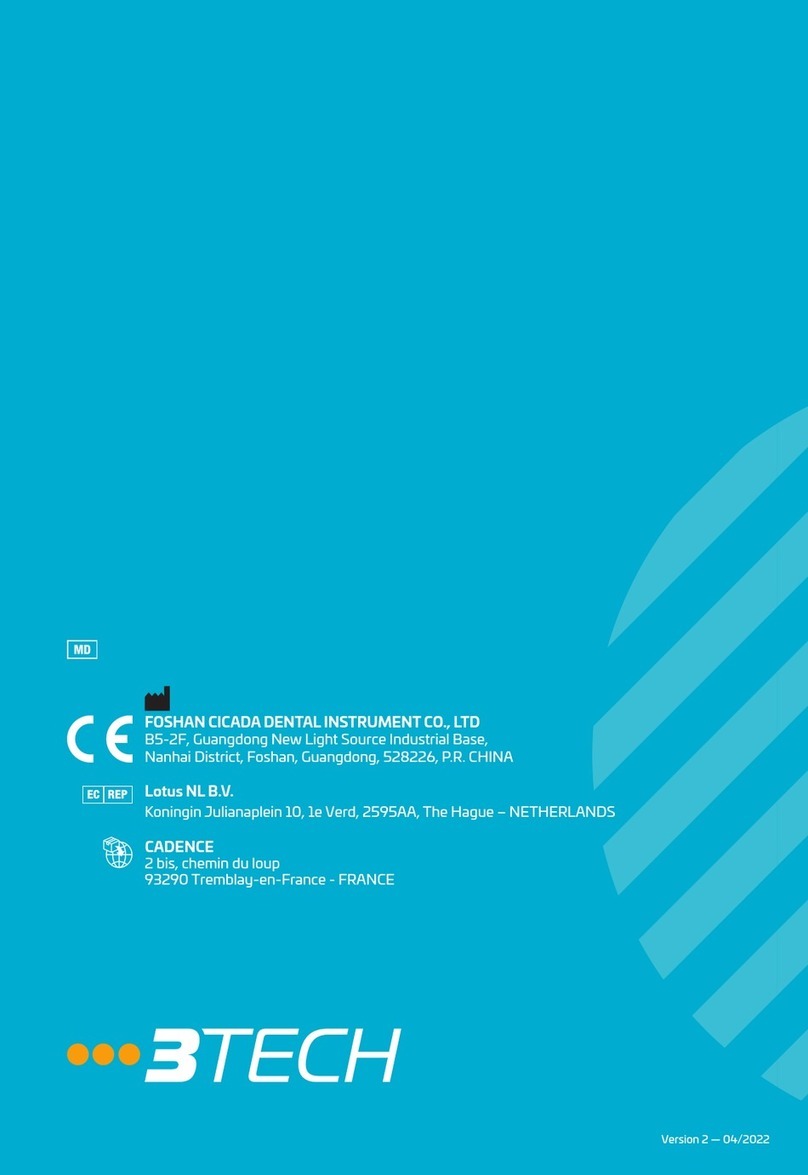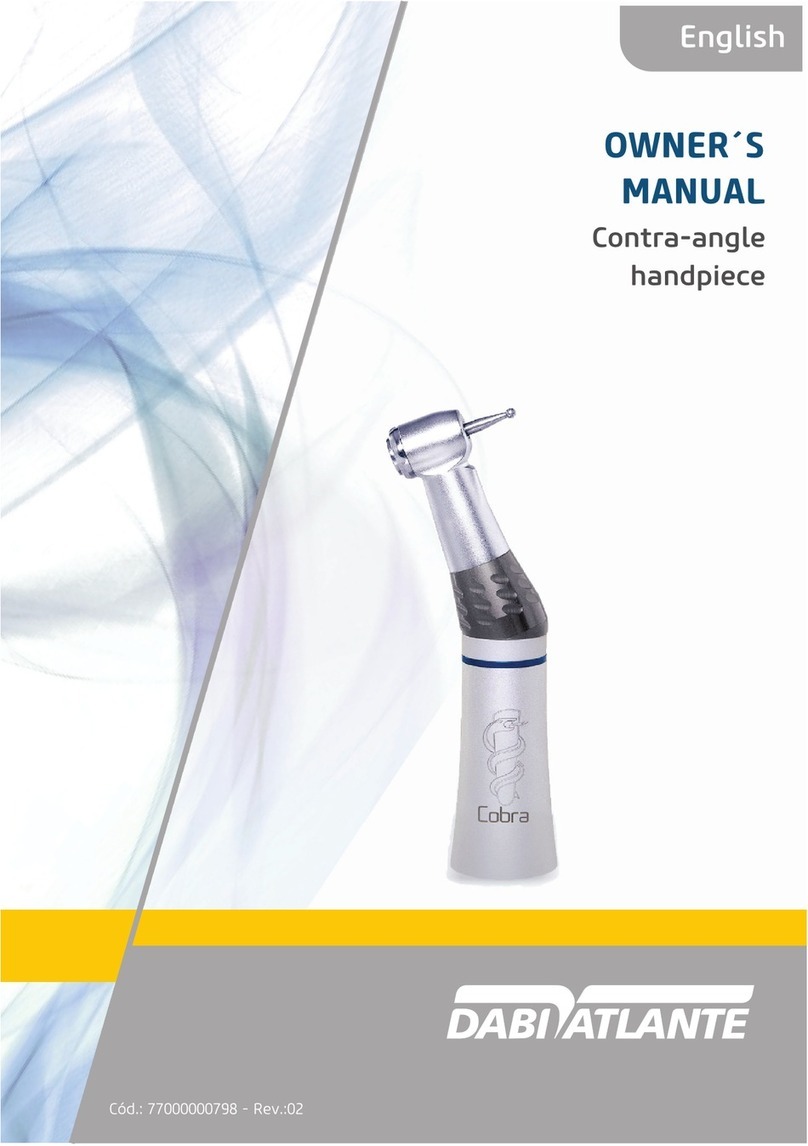SDI Radii-cal User manual

UNPACKING AND INITIAL CHARGING
The Radii-cal has been carefully packed to withstand any damage during transit.
Ensure all parts contained within the box match the product contents list above.
1) Remove all parts from the box.
2) Place the plug pack cable into the charger.
3) Plug the plug pack into an available power outlet and turn power outlet on.
The charger will conduct a brief LED test: the charge light LED should momentarily
show red/green and the 5 blue radiometer LEDs should turn on/off.
4) Place the curing light handpiece into the charger. The handpiece can be rotated
360º in the charger. Depending on the length of time from manufacture to
package opening, the charge remaining in the battery can vary. The charge light
will show the below three conditions.
Charge Light Color Battery condition
Red discharged
Flashing Green charging (OK to use)
Green charged
To ensure the highest level of performance, allow the Radii-cal to fully charge prior
to first use. On average, it will take approximately 1-3 hours to initially charge the
Radii-cal.
OPERATION
• Turning unit on and off
Simply pick up the curing light handpiece, press the on/off button once to activate
and de-activate the light. Audible beeps facilitate accurate time measurement of
curing. Replace the Radii-cal back in the charger when not in use.
• Audible beeps
An audible beep will be heard after the first 15 seconds (5 second ramp, 10
seconds full cure) two audible beeps after a further 10 seconds then three audible
beeps after an additional 10 seconds etc. The full cycle will continue as follows;
Audible beeps Time between beeps Total elapsed time
(seconds) (seconds)
1 short beep 15 sec 15 sec
2 short beeps 10 sec 25 sec
3 short beeps 10 sec 35 sec
4 short beeps 10 sec 45 sec
5 short beeps 10 sec 55 sec
1 long beep 10 sec 65 sec
At the end of 65 seconds one long beep will be heard before the blue LED is
automatically switched off.
• Lens Cap
The Radii-cal has been supplied with a lens cap fitted. The lens cap should be
inspected prior to each use for scratches, cracks or foreign matter that may reduce
the effectiveness of the LED light source. Generally lens caps should be replaced
every 2 weeks. To remove the lens cap carefully unscrew the old lens cap counter-
clockwise and fit the new lens cap by tightening clockwise.
• Built in Radiometer
The Radii-cal’s built-in radiometer provides a simple test to check the
functionality of the unit. With the Radii-cal on, carefully position the lens
cap on the built-in radiometer. 4 or 5 lights should illuminate indicating a
fully functional unit. If only 1,2 or 3 lights illuminate, it could be due
to the following reasons:
1) There could be some material on the lens cap such as composite: - the
lens cap should be replaced.
2) The lens cap could be damaged or cracked: - it should be replaced.
3) The battery could be extremely low - the unit should be recharged.
4) In a severe case the light could be malfunctioning: - the unit should be serviced.
Note: Portable radiometers can give inaccurate and inconsistent results. These
results can vary by as much as 300 mW/cm2or more.
• Disposable barrier sleeves
Transparent, disposable barrier sleeves are supplied to protect the handpiece and
prevent cross contamination. Testing showed no significant difference in spectral
and energy output when operating with or without a barrier sleeve in place.
Slide the barrier sleeve over the end of the handpiece before placing the orange
light shield on the end of the handpiece.
It is essential to use disposable barrier sleeves to prevent any liquids
getting on the handpiece. Evidence of liquids entering handpiece causeing
damage due to not using barrier sleeves will void warranty.
• Automatic shut off function
Should the Radii-cal LED become too hot due to excessive use (after about 4
minutes of continuous irradiation), the unit will automatically shut off and be
un-usable for about 1 minute until it cools down.
• Changing the battery pack
Carefully unscrew the battery pack counter-clockwise to remove and replace. A
single beep will be heard when the battery pack is successfully connected.
• Cleaning the Radii-cal:
The ideal way to protect patients from cross-infection is to utilise Radii-cal barrier
sleeves. Barrier sleeves are also essential to keep the Radii-cal clean. When cleaning
the Radii-cal handpiece, ensure control section, lens cap and battery pack are
connected as one unit.
Thank you for purchasing the Radii-cal LED curing light. The Radii-cal
is a powerful, cordless, lightweight curing light using an LED for the
polymerization of composite restorative materials that contain the photo-
initiator Camphorquinone. The Radii-cal produces a strong blue light in the
wavelength range of 440 – 480 nm, the relevant range for Camphorquinone
containing products.
PRODUCT CONTENTS LIST
• Handpiece
• Charger
• Plug pack
• 100 barrier sleeves
• 3 lens caps
• Light shields (5 Pack)
INSTRUCTIONS FOR USE
• LIQUIDCONTACTWITHTERMINALSOF
HANDPIECEANDCHARGERWILLCAUSE
DAMAGEVOIDINGWARRANTY.
• LIQUIDCONTACTWITHLEDWILLCAUSE
DAMAGEVOIDINGWARRANTY.
• LIQUIDSMUSTNOTENTERANYPARTOFTHE
HANDPIECE OR CHARGER.
• DONOTSPRAYLIQUIDSDIRECTLYONTO,OR
APPLYCOPIOUSAMOUNTSOFLIQUIDSTO
THE RADII-CAL.
• DONOTAUTOCLAVETHERADII-CAL.
General Surface Cleaning
General surface cleaning can be conducted with anti-microbial surface disinfectant
such as Glutaraldehyde, Chlorhexidine gluconate, and 70% Isopropyl alcohol. When
applying the disinfectant to any component of the device, spray the disinfectant
agent onto a piece of cloth and wipe over the external areas to be cleaned.
• Curing Times
Curing times will differ for different formulations of composite restorative
materials. Follow the manufacturers instructions for recommended curing times.
Always bench test new materials before use in-vivo.
• Disposal of battery pack
As a means of protecting the environment, the Radii-cal battery pack is fitted with
a Lithium Ion battery pack. Dispose of battery pack in accordance with local legal
regulations.
TROUBLE SHOOTING
Problem Causes Solution
• Charge light flashes Possible battery fault Replace battery
red
• Handpiece blue LED Battery charged too Re-charge battery
flashes then goes off low
• No lights appear on the 1. Check terminals on the battery are clean
charger when the hand and free of debris.
piece is placed on 2. Check power is getting to charger, turn
the charger. power outlet on. The charge light LED should
momentarily show red/green and the 5 blue
radiometer LEDs should turn on/off.
3. Check the power outlet is turned on, if so use
a different power outlet.
4. Check the plug pack is correctly connected to
the charger.
5. Check that the hand piece is placed into the
charger correctly.
6. If the problem still exists after checking 1, 2,
3 and 4 above the charger may be faulty. Return
the unit to the supplier for service.
When returning faulty units please make sure that all parts are returned together in
the original packaging.
SAFETYANDPRECAUTIONS
The safe operation of this unit depends on strictly following the operating
instructions in this manual. The Manufacturer accepts no liability for any damage
resulting from the use of this unit for any other purpose than the polimerization of
dental composite materials.
- The equipment can not be exposed or immersed in water or wet locations. The
equipment does not have protection against liquid penetration.
- Not appropriate to use the equipment in flammable mixtures.
CAUTION! Irradiation of the eyes bears an inherent health risk. Hence,
the light must not be directed towards the eyes. Exposure must be
restricted to the area of the oral cavity in which clinical treatment is
intended. Suitable blue-light filtering safety goggles should be used.
The Radii-cal emits a high intensity light and intensive light exposure of
soft tissues (gingiva, oral mucosa and skin) should be avoided as this
exposure may cause damage or irritation.The emitted light should be
placed directly above the material to be cured. If applicable cover soft
tissue areas.
Do not use the Radii-cal in patients or by users with:
• heart pacemaker implants who have been advised to be
cautious in regards to their exposure to small electrical devices.
• a history of photo biological reactions (including individuals
with urticaria solaris or erythropoietic protoporphyria) or who are
currently on photo-sensitizing medication (including 8-methoxypsoralen
or dimethylchlorotetracycline).
• a history of cataract surgery. These people may be particularly
sensitive to the exposure to light and should be discouraged from Radii-cal
treatment unless adequate safety measures, such as the use of
protective goggles to remove blue light, are undertaken.
• a history of retinal disease. These people should seek advice from
their ophthalmologist prior to operating the unit. In operating the Radii
-cal unit, this group of individuals must take extreme care and comply
with all safety precautions (including the use of suitable light-filtering
safety goggles).
WARRANTYPERIOD
SDI Ltd., the Manufacturer, extends a two year warranty against defects in
materials or workmanship to the original purchaser of this product.
The Manufacturer agrees to correct any defects which develop within the warranty
period, either by repair or replacement, at its option. This warranty is valid
providing factory inspection indicates that any such defect developed during
normal and proper use subject to the conditions below.
WARRANTYCONDITIONS-PLEASEREADCAREFULLY
• Please fill out the warranty card included in kit and send promptly
backtoSDIwithproofofpurchase.Failuretodosomayvoidyour
warranty.
• Alternatively goto http://www.sdi.com.au/warranty to register your
warranty.
a) Claims for damage in shipment should be filed promptly with the transportation
company.
b) All shipments claimed defective can only be returned to the Manufacturer
with the written consent of the Manufacturer. All returned products must be
accompanied by a full description of discrepancy or malfunction.
c) Only SDI authorized service personnel are allowed to carry out repairs to the
Radii-cal. Manufacturer shall be released from all obligations under this warranty
if repairs or modifications are made by persons other than Manufacturer’s own or
authorized service personnel.
d) Use only SDI parts exclusively to replace defective components. The product
warranty does not cover any damage resulting from the use of third-party
replacements parts.
e)Manufacturershallbereleasedfromallobligationsunderthiswarranty
in the event of improper installation; damage due to casualty; or obvious
misuse including but not limited to damage from liquids and autoclaving.
f) Manufacturer shall in no event be liable for any consequential damages arising
from the misuse of the product.
g) Only the above stated warranty shall be applicable, and all other warranties,
expressed or implied, are hereby excluded.
All correspondence concerning the product should specify the model and serial
number.
TECHNICAL DATA
Equipment powered internally.
Handpiece (battery, control section and standard LED attachment)
- wavelength range: 440 nm – 480 nm
- peak wavelength range: 460 nm
- RAMP to full intensity: 5 seconds
- light intensity: 1200 mW/cm2(peak)
- duration of continuous use 60 seconds
- total continuous run time
with fully charged battery: 3 hours, 20 minutes
- dimensions: 22mm diameter x 243mm long
- weight: 144g /5.1 ounces
- battery: 2 x 4.2V Lithium Ion – 1400 mAh
- battery powered internally.
Plug Pack
- input voltage: 90 – 264V – 50/60 Hz
- output voltage: 12V DC
- output current: 750 mA
- dimensions: 70mm high x 45mm wide x 50mm long
- weight: 80g / 2.82 ounces
Charger
- time to charge battery: 60 – 180 minutes
- operating temperature: 10ºC - 40ºC
- total height with handpiece
inserted: 255mm
- dimensions: 70mm wide x 40mm high x 130mm long
- weight 84g / 3 ounces
According to classification IEC 60601-1
REPLACEMENTPARTSANDACCESSORIES
Replacement parts and accessories which can be installed without special training
or equipment, can also be obtained from your authorized SDI dealer.
Re-order Code
Replacement lens caps (25 Pack) 5600054
Barrier sleeves (1000 pack) 5600055
Light shield (5 Pack) 5600056
Radii-cal Control Section 5600106
Radii-cal Battery 5600105
Radii-cal Charger (includes plug pack)
- Australia/New Zealand 5600110
- United Kingdom 5600111
- North and South America / Asia 5600112
- Europe 5600113
- China 5600114
LED Radiometer 5600028
Date of issue of last revision : 07 - 2012
radii-cal
PAK41169 E
CAUTION
(refer to accompanying
instructions)
Type B Applied Part
Class II Equipment
Transport and storage environment:
Ambient temperature: 0˚C - 40˚C (32˚F - 104˚F)
Relative humidity: 10% - 85%
Atmospheric pressure: 0.5 atm - 1.0 atm (500 hPa to 1060 hPa)
Charger
Radiometer
indicators
Charge light
Lens cap
Control section
On/off button
Handpiece
Battery pack
Radiometer
E
N
G
L
I
S
H
Made in Australia by SDI Limited
Bayswater, Victoria 3153
Australia 1 800 337 003
Austria 00800 022 55 734
Brazil 0800 770 1735
France 00800 022 55 734
Germany 0800 100 5759
Ireland 01 886 9577
Italy 800 780625
New Zealand 0800 734 034
Spain 00800 022 55 734
United Kingdom 00800 022 55 734
USA & Canada 1 800 228 5166
www.sdi.com.au
SDI Dental Limited
Block 8, St Johns Court
Swords Road, Santry
Dublin 9, Ireland
Tel +353 1 886 9577
Last Revised: 10 - 2012

Table201-GuidanceandMANUFACTURER’Sdeclaration-ELECTROMAGNETICEMISSIONS-forallequipmentandsystems
Guidanceandmanufacturer’sdeclaration-electromagneticemissions
The Radii-Cal is intended for use in the electromagnetic environment specified below. The customer or the user of the Radii-Cal should assure that it is used in such an environment.
Emissions test Compliance Electromagnetic environment - guidance
RF emissions
CISPR 11
Group 1 The Radii-Cal uses RF energy only for its internal function. Therefore, its RF emissions are very low and are not likely to cause any interference in
nearby electronic equipment.
RF emissions
CISPR 11
Class B The Radii-Cal is suitable for use in all establishments, including domestic establishments. The Radii-Cal is powered by 2 x 4.2V DC Lithium ion
batteries thus Harmonic emission and Voltage uctuation/icker emissions are not applicable.
Harmonic emissions IEC 61000-3-2 Not applicable
Voltage uctuations / icker emissions IEC 61000-3-3 Not applicable
Table202-GuidanceandMANUFACTURER’Sdeclaration-ElectromagneticIMMUNITY-forallequipmentandsystems
Guidanceandmanufacturer’sdeclaration-electromagneticimmunity
The Radii-Cal is intended for use in the electromagnetic environment specified below. The customer or the user of the Radii-Cal should assure that it is used in such an environment.
IMMUNITYtest IEC 60601 test level Compliance level Electromagnetic environment - guidance
Electrostatic discharge (ESD) IEC 61000-4-2 +/- 6 kV contact
+/- 8 kV air
+/- 6 kV contact
+/- 8 kV air
Floors should be wood, concrete or ceramic tile. If oors are covered with synthetic material, the
relative humidity should be at least 30%.
Power frequency (50/60 Hz) magnetic eld IEC 61000-4-8 3 A/m 3 A/m Power frequency magnetic fields should be at levels characteristic of a typical location in a typical
commercial or hospital environment.
Table204-GuidanceandMANUFACTURER’Sdeclaration-ElectromagneticIMMUNITY-forallequipmentandsystemsthatarenotLIFE-SUPPORTING
Guidanceandmanufacturer’sdeclaration-electromagneticimmunity
The Radii-Cal is intended for use in the electromagnetic environment specified below. The customer or the user of the Radii-Cal should assure that it is used in such an environment.
IMMUNITYtest IEC 60601 test level Compliance level Electromagnetic environment - guidance
Radiated RF IEC 61000-4-3 3 V/m 80 MHz to 2,5 GHz 3 V/m Portable and mobile RF communications equipment should be used no closer to any part
of the TENS PRO 900, including cables, than the recommended separation distance calcu-
lated from the equation applicable to the frequency of the transmitter.
Recommended separation distance
Where P is the maximum output power rating of the transmitter in watts (W) according to
the transmitter manufacturer and dis the recommended separation distance in metres (m).
Field strengths from fixed RF transmitters, as determined by an electromagnetic site survey,
a should be less than the compliance level in each frequency range .b
Interference may occur in the vicinity of equipment marked with the following symbol:
NOTE 1 At 80 MHz and 800 MHz, the higher frequency range applies.
NOTE 2 These guidelines may not apply in all situations. Electromagnetic propagation is affected by absorption and reection from structures, objects and people.
a Field strengths from fixed transmitters, such as base stations for radio (cellular/cordless) telephones and land mobile radios, amateur radio, AM and FM radio broadcast and TV broadcast cannot be predicted theoretically with
accuracy. To assess the electromagnetic environment due to fixed RF transmitters, an electromagnetic site survey should be considered. If the measured field strength in the location in which the Radii-Cal is used exceeds the
applicable RF compliance level above, the Radii-Cal should be observed to verify normal operation. If abnormal performance is observed, additional measures may be necessary, such as re-orienting or re-locating the Radii-
Cal.
Table206-RecommendedseparationdistancesbetweenportableandmobileRFcommunicationsequipmentandtheequipmentandsystems-forequipmentandsystemsthatarenotLIFE-SUPPORTING
RecommendedseparationdistancesbetweenportableandmobileRFcommunicationsequipmentandtheRadii-Cal
The Radii-Cal is intended for use in an electromagnetic environment in which radiated RF disturbances are controlled. The customer or the user of the Radii-Cal can help prevent electromagnetic interference by maintaining a
minimum distance between portable and mobile RF communications equipment (transmitters) and the Radii-Cal as recommended below, according to the maximum output power of the communications equipment.
Rated maximum output power of trans-
mitter W
Separation distance according to frequency of transmitter m
80MHz10800MHz 800MHza2,5GHz
0,01 0.12 0.23
0.1 0.38 0.73
1 1.2 2.3
10 3.8 7.3
100 12 23
For transmitters rated at a maximum output power not listed above, the recommended separation distance din metres (m) can be estimated using the equation applicable to the frequency of the transmitter, where Pis the
maximum output power rating of the transmitter in watts (W) according to the transmitter manufacturer.
NOTE 1 At 80 MHz and 800 MHz, the separation distance for the higher frequency range applies.
NOTE 2 These guidelines may not apply in all situations. Electromagnetic propagation is affected by absorption and reection from structures, objects and people.
Table of contents
Other SDI Dental Equipment manuals
Popular Dental Equipment manuals by other brands
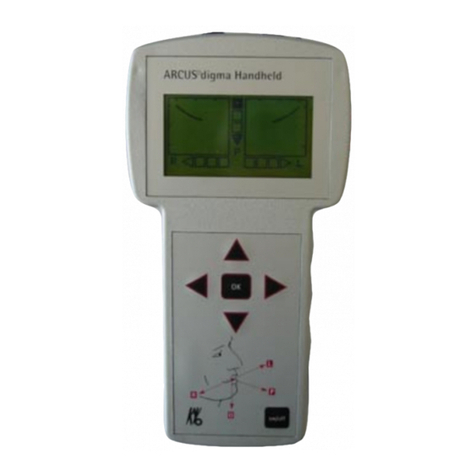
KaVo
KaVo ARCUS digma operating instructions
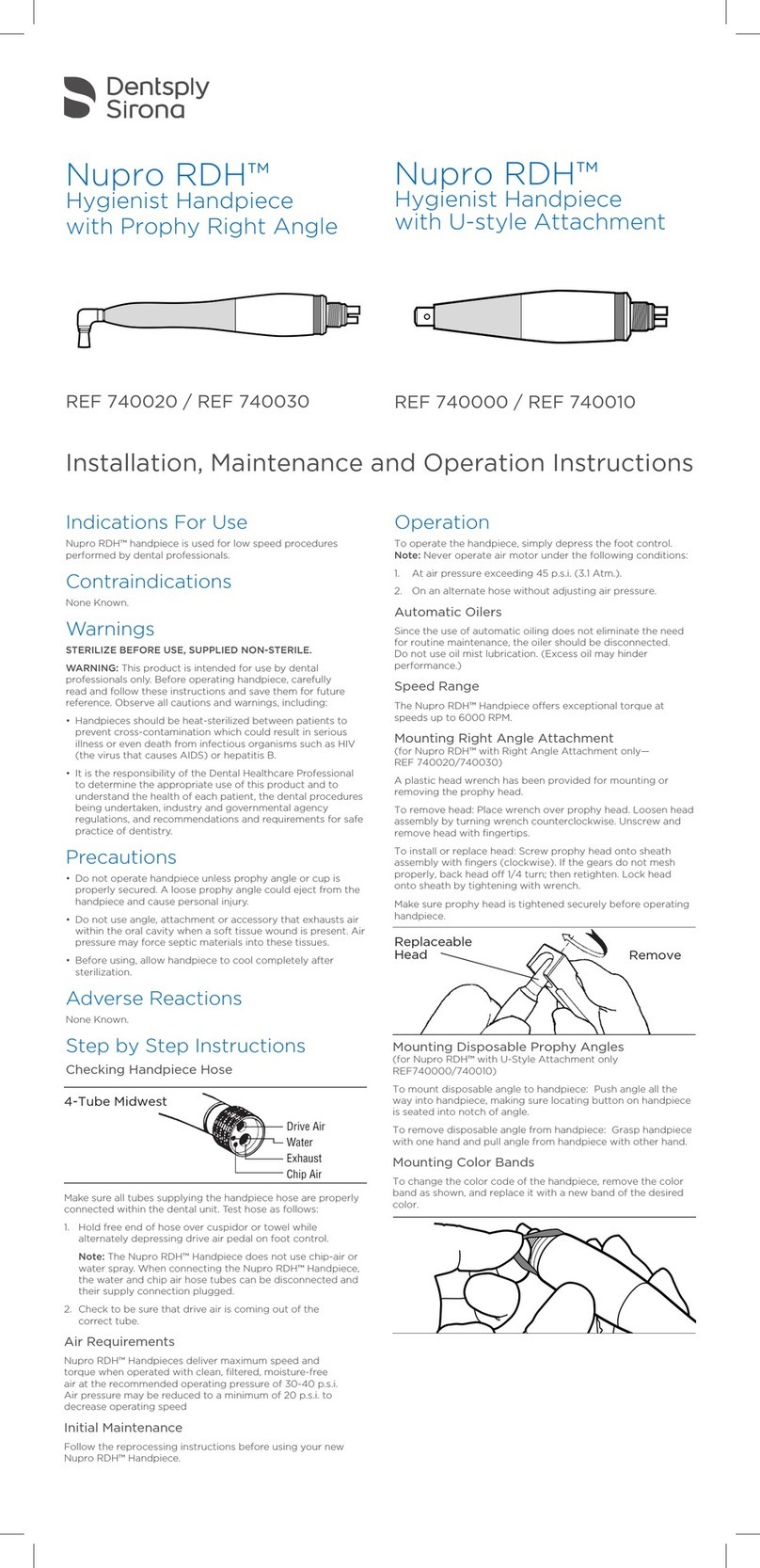
Dentsply Sirona
Dentsply Sirona Nupro RDH 740000 Installation, maintenance and operation instructions
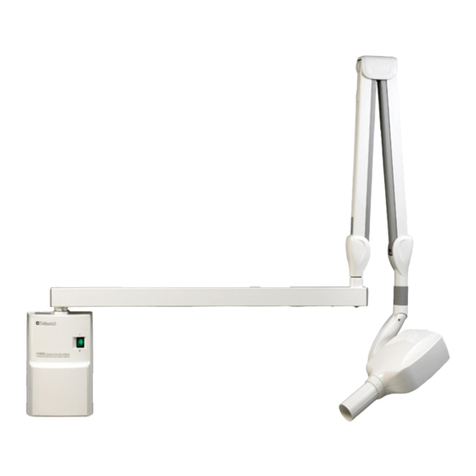
Belmont
Belmont BELRAY II 097 installation instructions

DentLight
DentLight FUSION Instructions for use
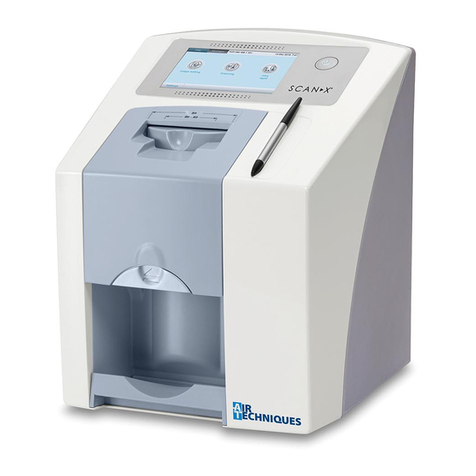
Air Techniques
Air Techniques ScanX Swift Installation and operating instructions
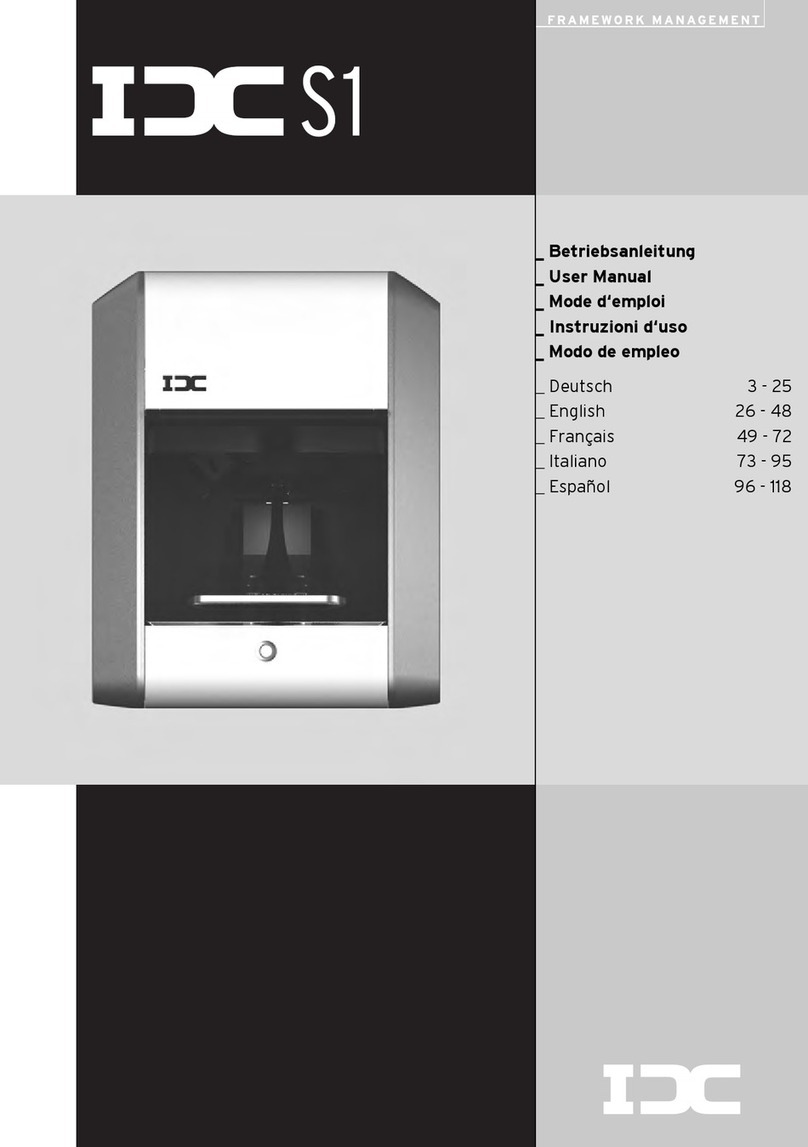
IDC
IDC S1 user manual
